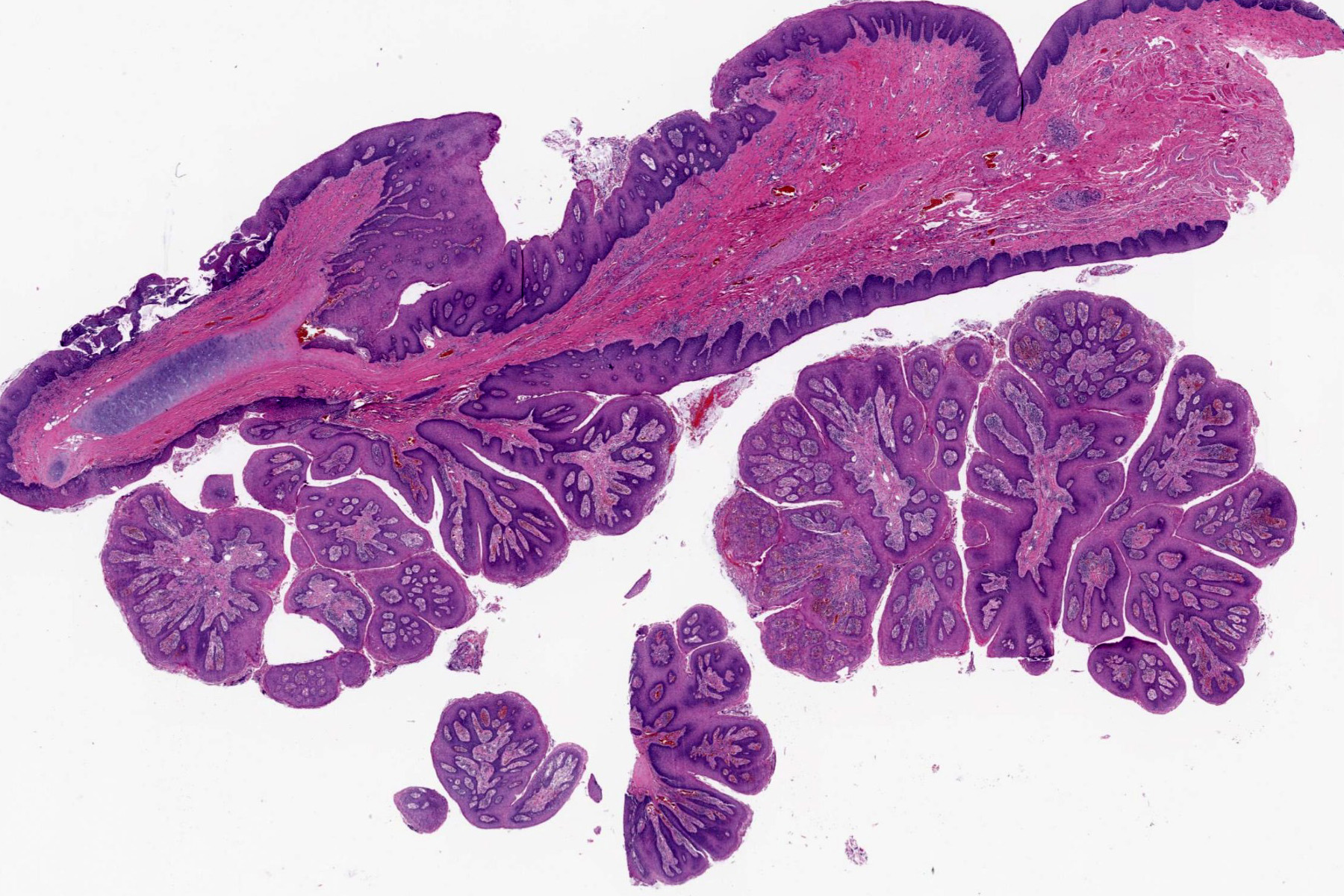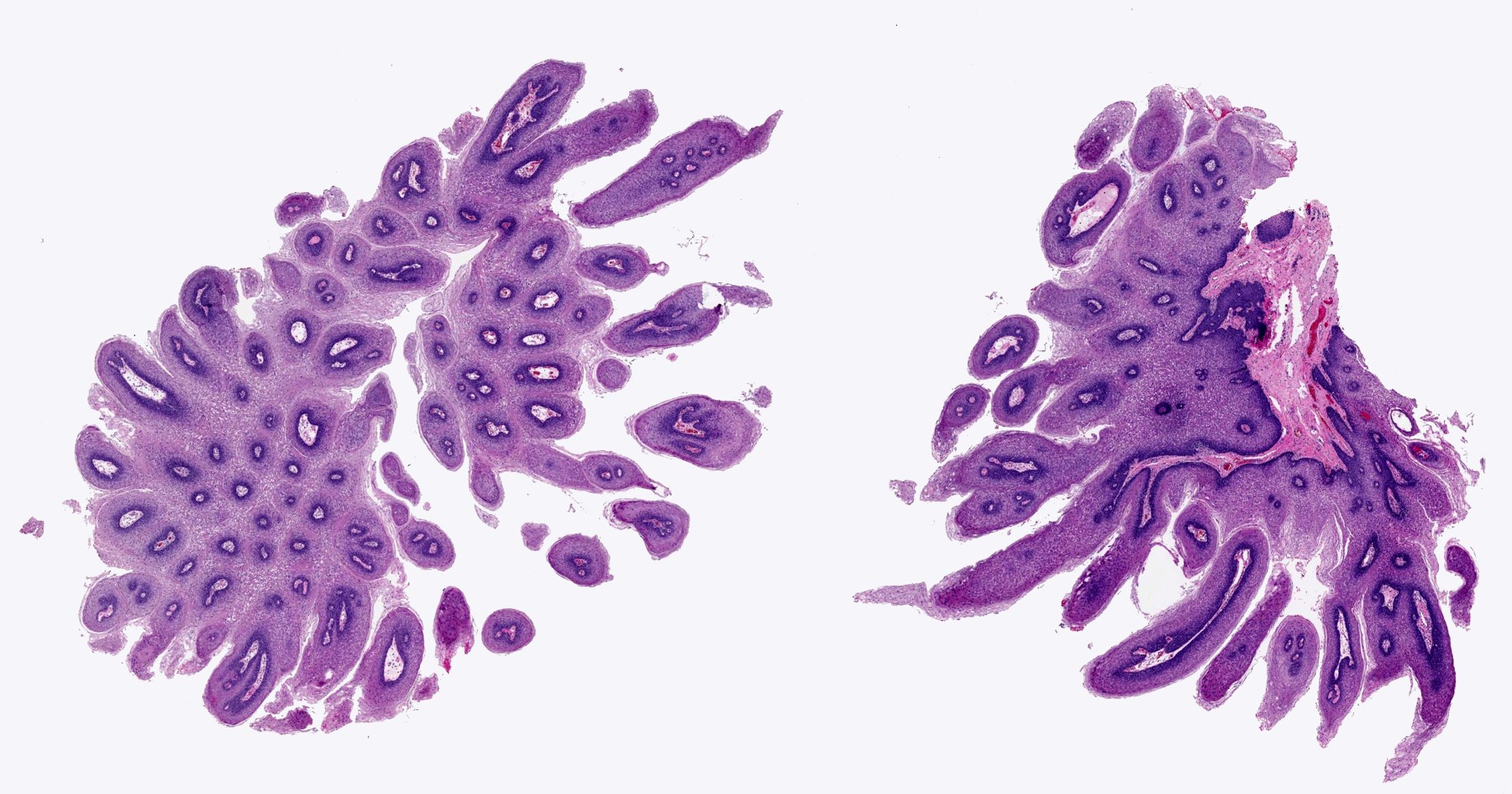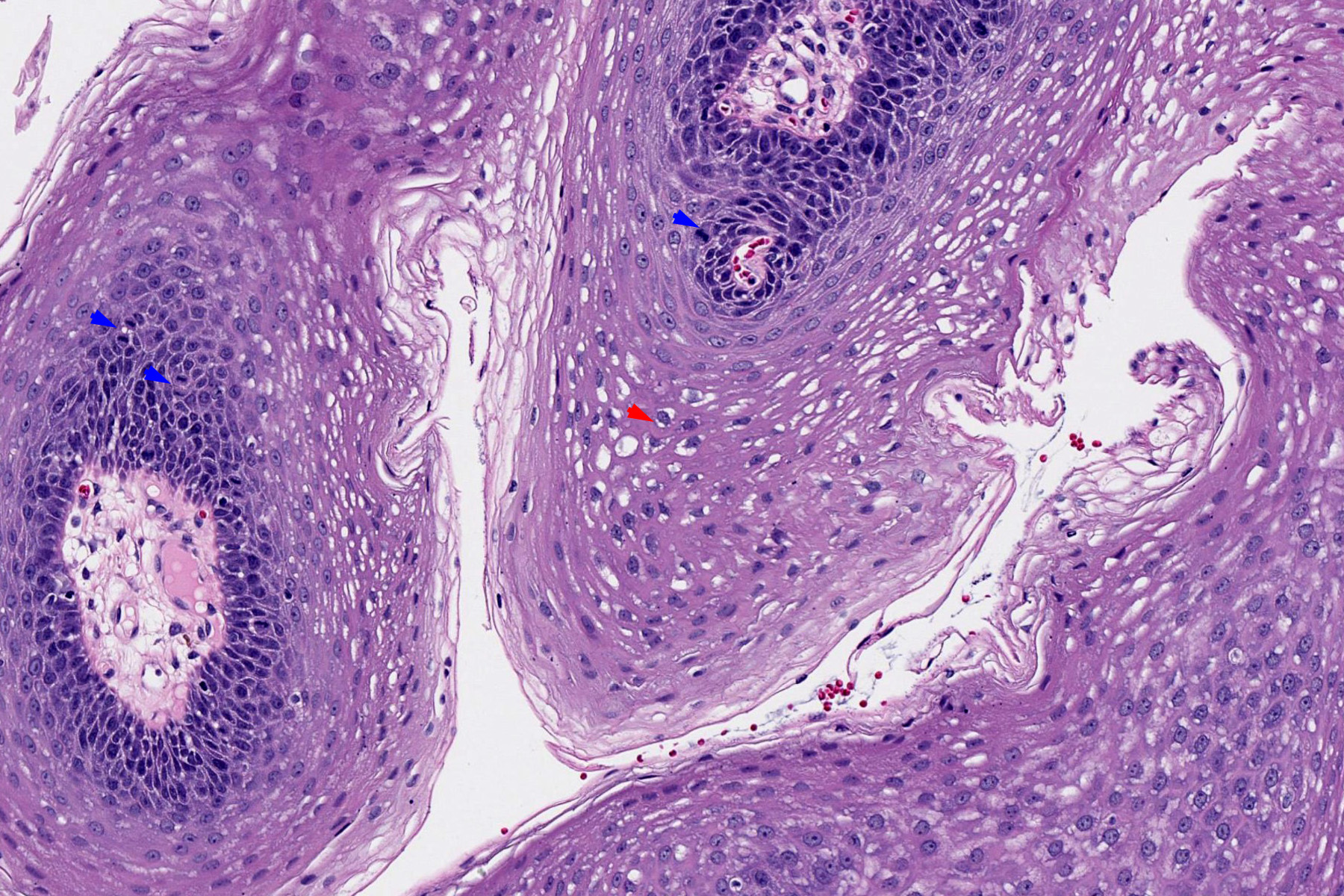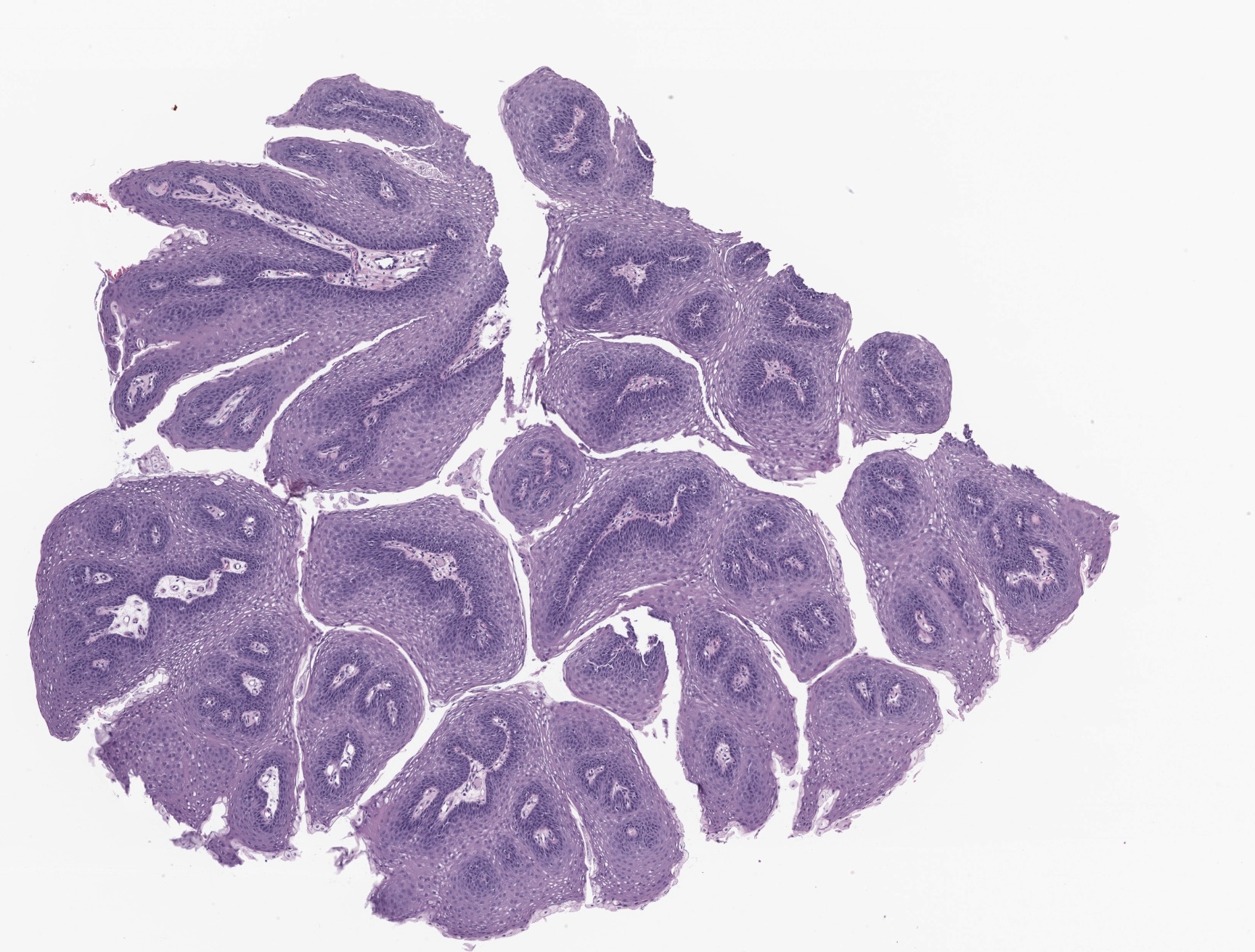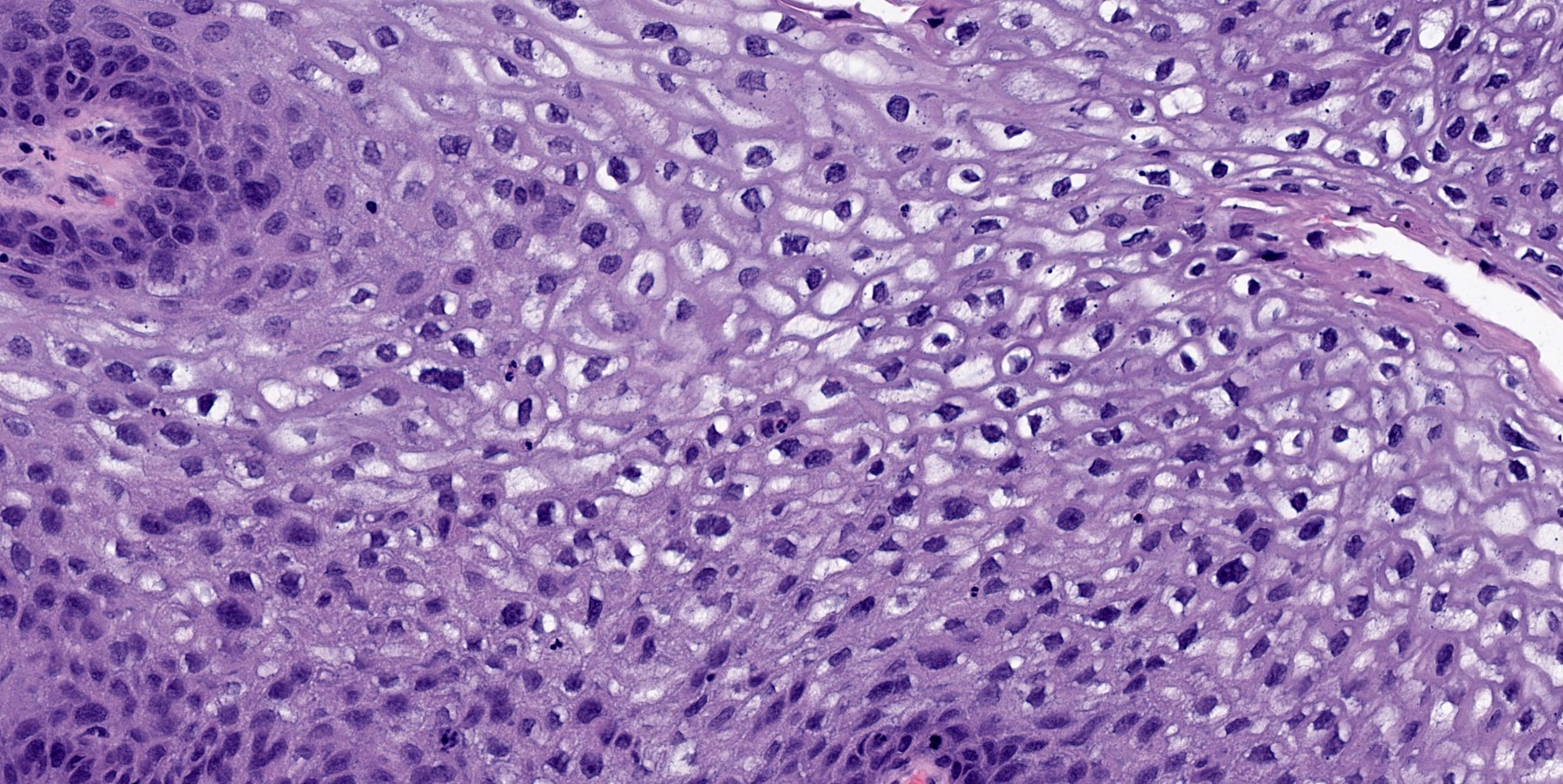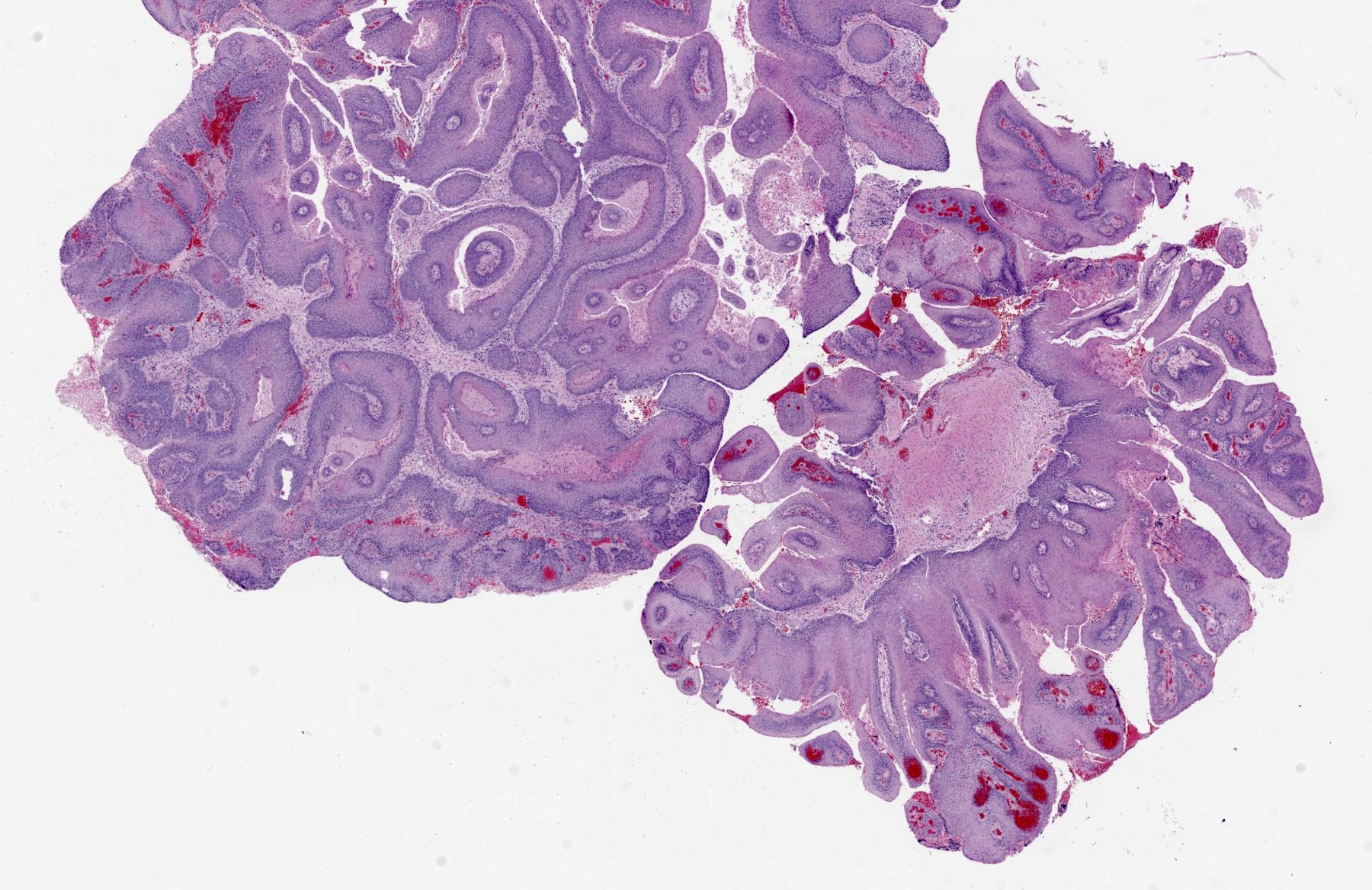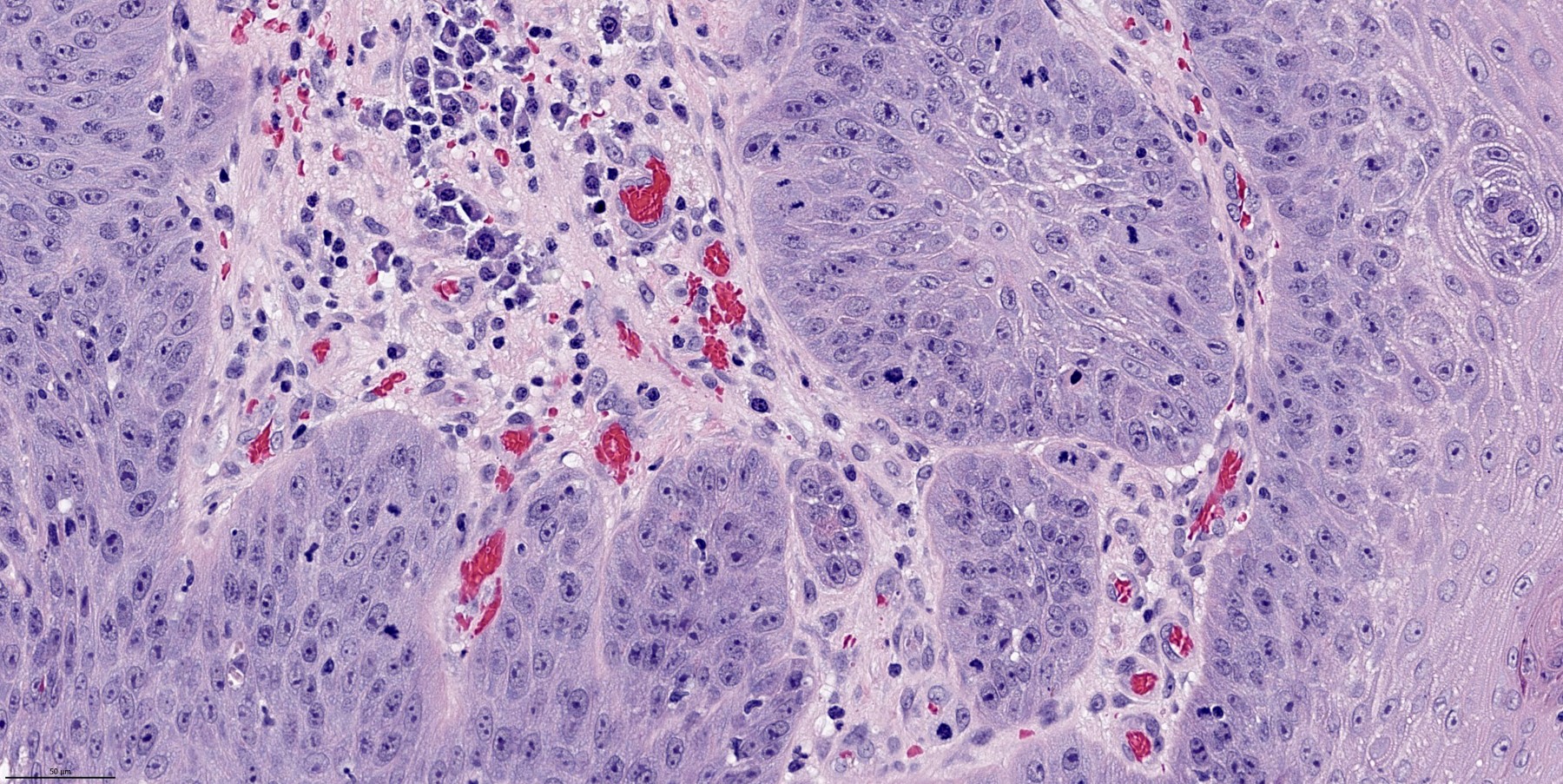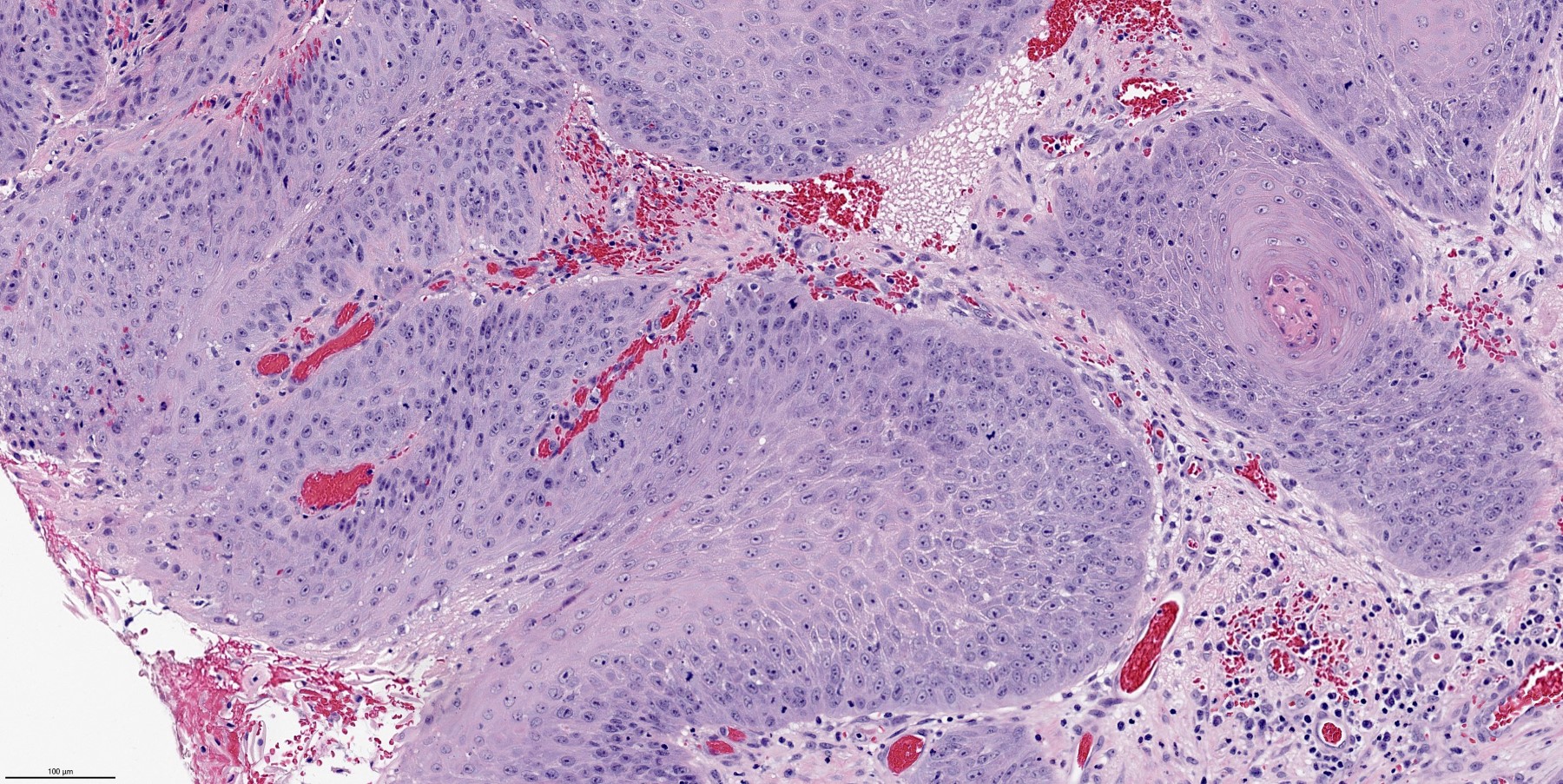Table of Contents
Definition / general | Essential features | Terminology | ICD coding | Epidemiology | Sites | Pathophysiology | Etiology | Clinical features | Diagnosis | Radiology description | Radiology images | Prognostic factors | Case reports | Treatment | Gross description | Gross images | Microscopic (histologic) description | Microscopic (histologic) images | Positive stains | Sample pathology report | Differential diagnosis | Additional references | Board review style question #1 | Board review style answer #1 | Board review style question #2 | Board review style answer #2 | Board review style question #3 | Board review style answer #3Cite this page: Umrau K, Xu B. Papilloma. PathologyOutlines.com website. https://www.pathologyoutlines.com/topic/larynxpapilloma.html. Accessed April 25th, 2024.
Definition / general
- Benign, exophytic squamous epithelial proliferation that is composed of branching papillary fronds with central fibrovascular cores lined by hyperplastic nonkeratinizing squamous epithelium, usually associated with low risk human papilloma virus (HPV) infection; in particular, genotypes 6 and 11
Essential features
- Benign exophytic / papillary squamous proliferation
- Branching papillae with central fibrovascular cores covered by hyperplastic squamous epithelium
- Associated with low risk HPV infection; in particular, genotypes 6 and 11
Terminology
- Squamous papilloma
- Squamous cell papilloma
- Squamous papillomatosis
- Squamous cell papillomatosis
- Recurrent respiratory papillomatosis
- Laryngeal papillomatosis
- Juvenile onset papillomatosis
- Adult onset papillomatosis
ICD coding
- ICD-O:
- ICD-10: D14.1 - benign neoplasm of larynx
- ICD-11: 2F00.1 & XA2RH5 & XH50N3 - recurrent respiratory papillomatosis & larynx & squamous papillomatosis
Epidemiology
- Most common benign epithelial tumor of the larynx
- Incidence: 43 per million in children, 18 - 23 per million in adults (Laryngoscope 2008;118:1236, Ther Clin Risk Manag 2015;11:731)
- Bimodal age distribution of disease onset:
- Children: often occurs in < 5 years, no sex predilection
- Adults: most frequently impacts patients in their 20s to 40s but may occur at any age; male predominant with M:F = ~3:2
- Decreased incidence in children since the introduction of quadrivalent HPV vaccination program (J Infect Dis 2018;217:208)
Sites
- Affects sites where ciliated respiratory type and squamous epithelium are juxtaposed
- Most frequently occurs in the larynx (involving the true vocal folds and ventricles), followed by the false vocal cords (Laryngoscope 2018;128:138)
- May rarely extend to extralaryngeal locations, such as epiglottis, subglottic area, hypopharynx and nasopharynx, tracheobronchial tree and pulmonary parenchyma (Respir Med 2017;126:116)
Pathophysiology
- HPV binds and replicates in the nuclei of the basal cell layer of metaplastic squamous mucosa (Laryngoscope Investig Otolaryngol 2019;4:89)
- The virus establishes itself through nonproductive replication as a low copy number episome by using the host DNA replication machinery
- Low viral load in the basal cells contributes to immune evasion and viral persistence (Laryngoscope Investig Otolaryngol 2019;4:89)
- HPV DNA replication can cause tumorogenesis and epithelial stratification
Etiology
- Virus induced lesion caused by low risk HPV
- Low risk HPV is detected in over 90% of patients
- Most common genotype is HPV6 (in 64%) followed by HPV11 (in 19%) (Viruses 2021;13:1624)
- Mode of infection differs according to patient's age
- Children: mostly vertical transmission at birth
- Firstborn child, vaginal delivery, maternal age < 20 years and active maternal genital HPV infection, are risk factors
- Cesarean section decreases the risk (Viruses 2021;13:1624)
- Adult: sexual contact and reactivation of latent infection from childhood
- Children: mostly vertical transmission at birth
- Unknown etiology in HPV negative papilloma / papillomatosis, which occurs mostly in adult setting and is associated with an increased risk of laryngeal carcinoma (PLoS One 2014;9:e99114)
Clinical features
- Can be divided into 4 subtypes: juvenile solitary, juvenile multiple, adult solitary and adult multiple
- Children: triad of progressive hoarseness, stridor and breathing difficulty (Respir Med 2017;126:116)
- Adults: most commonly hoarseness (Respir Med 2017;126:116)
- Symptoms tend to be more severe in children, due to the rapid growth of lesions and propensity for airway obstruction
- In severe cases, patients develop airway obstruction and respiratory distress
Diagnosis
- Diagnosis is typically rendered on biopsy, using laryngoscopy or bronchoscopy
- Direct laryngoscopy or fiberoptic bronchoscopy shows exophytic or papillary lesion(s)
Radiology description
- Helical computed tomography (CT) is an accurate method to identify the location of the disease and to characterize airway narrowing (Otolaryngol Clin North Am 2019;52:669, Respir Med 2017;126:116)
Prognostic factors
- Clinical course is unpredictable
- Adverse risk factors associated with aggressive behavior of the lesion (e.g., extralaryngeal spread and recurrence) include: HPV11 infection, younger age of onset, tracheostomy performed to avoid airway obstruction and previous invasive procedures (Viruses 2021;13:1624)
- Carcinomatous transformation reported in 3 - 6% of patients; reported to be associated with pulmonary disease, adult onset disease, previous irradiation and smoking (Viruses 2021;13:1624)
Case reports
- 34 year old man with concomitant tonsillar cyst and papilloma of the larynx (Medicine (Baltimore) 2018;97:e11280)
- 65 year old woman with dyspnea for the past 20 years (Respir Med Case Rep 2022;36:101607)
- 73 year old man with adult onset recurrent respiratory papillomatosis and sarcoma (Iran J Otorhinolaryngol 2022;34:59)
Treatment
- Surgical approach (including laser ablation) is the current standard of care (Laryngoscope Investig Otolaryngol 2018;3:22)
- Other treatments include antiviral therapy (such as cidofovir) and intralesional injections of anti-angiogenic drugs (such as bevacizumab) (Respir Med 2017;126:116)
- HPV vaccine may decrease recurrence after surgical debridement (Otolaryngol Clin North Am 2019;52:669)
Gross description
- Can be solid or multiple, variable size
- Exophytic cauliflower-like, sessile or pedunculated pinkish-whitish masses with bosselated surfaces
- Mucosa appears velvety in microscopic (small) papillomas
Microscopic (histologic) description
- Finger-like projections or multiple fronds with a central fibrovascular core, covered by benign hyperplastic stratified squamous epithelium
- Basal and parabasal hyperplasia
- Increased mitotic figures in the basal and parabasal layers
- Koilocytic changes in upper layer: may be pronounced or subtle
- Surface keratinization: absent to minimal
- Malignant transformation is characterized by aberrant (paradoxical) keratinization, marked cytological atypia, focal necrosis, increased mitoses and atypical mitoses not limited to the basal and parabasal layers, as well as invasive growth pattern (Respir Med 2017;126:116)
Microscopic (histologic) images
Positive stains
- RNA or DNA in situ hybridization for low risk HPV is typically positive
- Integrated pattern detected by DNA in situ hybridization is associated with increased risk of recurrence in pediatric patients (Head Neck Pathol 2012;6:3)
Sample pathology report
- Larynx, biopsy:
- Squamous papilloma
Differential diagnosis
- Squamous cell carcinoma:
- Verrucous carcinoma and papillary squamous cell carcinoma may show verruciform or papillary architecture
- Verrucous carcinoma shows keratinization and broad pushing invasion
- Papillary squamous cell carcinoma shows marked cellular pleomorphism, full thickness mitotic activity and atypical mitoses
- Squamous cell carcinoma of the larynx is typically negative for low risk HPV
- Verruca vulgaris:
- Marked hyperkeratosis and prominent keratohyalin granules
- Lack of branching fibrovascular cores
- Rare in larynx
Additional references
Board review style question #1
Board review style answer #1
B. Squamous papilloma. The H&E image shows a squamous papilloma, a benign squamous proliferation with papillary projections.
Comment Here
Reference: Papilloma
Comment Here
Reference: Papilloma
Board review style question #2
What is the most common etiology of laryngeal squamous papillomatosis?
- HPV 11 and HPV 6
- HPV 16 and HPV 6
- HPV 16 and HPV 11
- HPV 16 and HPV 18
Board review style answer #2
Board review style question #3
Which of the following statements is true regarding laryngeal papillomas?
- Although uncommon, they can extend into the trachea and bronchus
- Recurrence is more frequent in adult patients compared with pediatric patients
- Surface keratinization and hyperkeratosis are present in most cases
- They are related to high risk human papilloma virus (HPV)
Board review style answer #3
A. Although uncommon, they can extend into the trachea and bronchus
Comment Here
Reference: Papilloma
Comment Here
Reference: Papilloma






